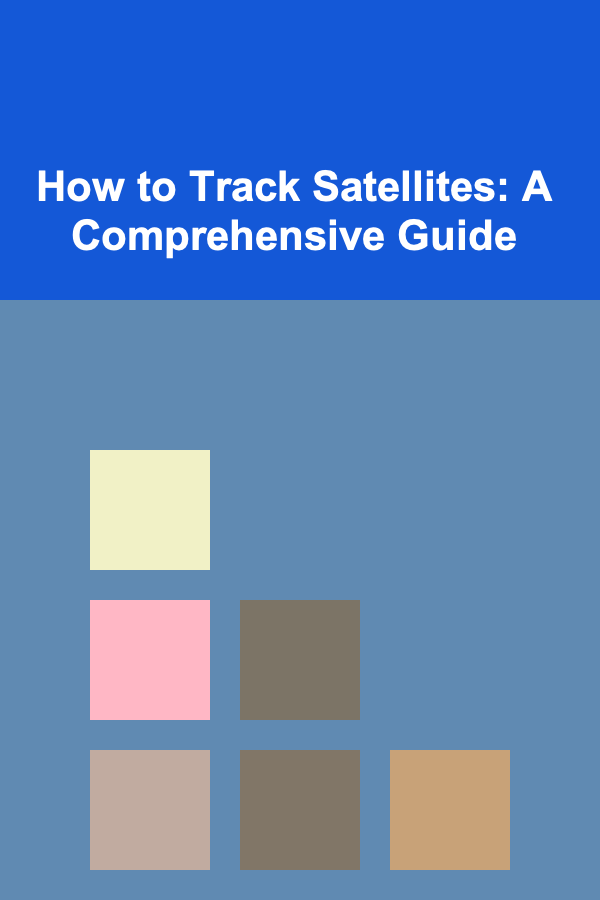
How to Track Satellites: A Comprehensive Guide
ebook include PDF & Audio bundle (Micro Guide)
$12.99$6.99
Limited Time Offer! Order within the next:

Tracking satellites is an exciting and intellectually stimulating activity that offers a unique perspective on the vast expanse of space. Whether for scientific purposes, amateur astronomy, or even just as a hobby, understanding how to track satellites can give you a deep insight into the movement of artificial objects in Earth's orbit. In this guide, we will delve into the methods, tools, and techniques you can use to track satellites, exploring both the technological and theoretical aspects of this fascinating subject.
Introduction to Satellites
Satellites are objects placed into orbit around the Earth or other celestial bodies. They serve a wide range of purposes, from telecommunications and weather monitoring to scientific research and GPS navigation. With over 3,000 active satellites currently orbiting Earth, there is a wealth of data that can be gathered from these machines.
Satellites can be classified into different categories depending on their orbit, mission, and usage:
- Geostationary Satellites: These orbit at about 35,786 km above Earth's equator and match Earth's rotation, making them appear stationary relative to the ground.
- Low Earth Orbit (LEO) Satellites: These orbit closer to Earth, typically at altitudes ranging from 160 km to 2,000 km, and complete an orbit in roughly 90 minutes.
- Medium Earth Orbit (MEO) Satellites: Positioned between LEO and geostationary orbits, they serve primarily for navigation systems like GPS.
Tracking satellites allows enthusiasts and professionals alike to predict when and where they will be visible from the Earth's surface. This practice not only aids scientific research but also contributes to a better understanding of space dynamics.
Basic Principles of Satellite Tracking
Satellite tracking involves predicting the position and motion of satellites as they orbit Earth. The movement of a satellite is governed by a few key principles:
- Orbital Mechanics: Satellites follow elliptical or circular orbits determined by gravitational forces and their velocity at launch. These orbits are calculated based on laws such as Kepler's laws of planetary motion and Newton's law of gravitation.
- Orbital Elements: To track a satellite's path, you need to know its orbital elements, which include details like its inclination, eccentricity, and the location of the ascending node. These elements define the satellite's orbit and allow predictions about its location.
- Keplerian Motion: Kepler's laws describe the motion of bodies in orbit. According to Kepler's first law, planets and satellites travel in elliptical orbits with the central body at one focus. This law helps predict the satellite's location based on the time since its last pass over a particular point on Earth.
Orbital Period and Satellite Speed
The orbital period refers to the time it takes for a satellite to complete one orbit around Earth. This period varies with altitude: satellites in LEO have a shorter orbital period (about 90 minutes), while those in geostationary orbit take 24 hours to complete one orbit. The speed of a satellite also varies with its altitude; lower-altitude satellites travel faster than those at higher altitudes.
Satellite Passes and Visibility
The visibility of a satellite from a particular location on Earth depends on several factors, such as:
- Satellite's Orbital Path: Whether the satellite is visible to you depends on where it is in its orbit. For example, a satellite in LEO will pass across the sky in a path that depends on its orbit and the observer's location on Earth.
- Time of Day: The best time to see a satellite is often during twilight or at night. This is because the satellite is still illuminated by the Sun, while the observer's location on Earth is in darkness.
- Weather and Atmospheric Conditions: Cloud cover and atmospheric interference can obstruct your view of satellites. Clear skies offer the best viewing conditions.
Tools and Techniques for Tracking Satellites
To accurately track satellites, you'll need specific tools and software to help predict their orbits and determine their positions in real-time. Here are some of the tools and techniques you can use:
1. Satellite Tracking Websites and Software
There are several online resources and software applications designed to track satellites and predict their movements. Some of the most popular ones include:
- Heavens-Above: This is a widely used website that provides detailed satellite tracking information. It allows you to track satellites in real-time, view upcoming passes, and even get alerts when a particular satellite will be visible from your location.
- N2YO: A website offering real-time satellite tracking and predictions for satellite passes. It includes details about satellite locations, orbital data, and upcoming passes.
- Satview: Another satellite tracker that allows users to view real-time satellite locations, as well as future passes and orbit predictions.
How These Websites Work
These websites rely on TLE (Two-Line Element) data, which contains the necessary orbital parameters of a satellite. TLE data is provided by organizations like NORAD and is used by tracking systems to predict where a satellite will be in the sky at any given moment.
2. Satellite Tracking Apps
Several apps are available for smartphones and tablets that make satellite tracking accessible on the go. Some popular ones include:
- SkySafari: An astronomy app that provides satellite tracking along with star maps and other celestial information.
- ISS Tracker: This app tracks the International Space Station (ISS) in real time and gives detailed information about when and where it will be visible in the sky.
- Star Walk 2: A popular stargazing app that includes satellite tracking as part of its features.
3. Using a Telescope or Binoculars
While apps and websites give you precise predictions, sometimes observing a satellite in the sky requires some physical equipment. If you want to get a closer view of the satellite, you can use:
- Binoculars: While binoculars won't provide detailed images of satellites, they are sufficient for spotting moving satellites against the night sky.
- Telescopes: With a telescope, you may be able to observe the satellite in more detail. However, due to the high speed of satellites, you'll need to have a tracking mount to keep the object in the field of view.
4. Radio Signals and Amateur Satellite Tracking
Some enthusiasts use radio signals to track satellites. Many satellites transmit signals, including amateur radio satellites. By receiving and interpreting these signals, you can track their position in space. Specialized receivers and antennas are required for this, and the practice can provide real-time data about a satellite's orbit.
5. Antennas and Software Defined Radio (SDR)
For more advanced satellite tracking, you can set up your own ground station using antennas and Software Defined Radio (SDR) equipment. SDR allows you to decode signals from satellites and track them with greater precision. This method is often used by satellite operators, engineers, and advanced amateur astronomers.
Key Factors Affecting Satellite Tracking
1. Orbital Decay
Over time, satellites can experience a phenomenon known as orbital decay. This occurs because of atmospheric drag, particularly for satellites in low Earth orbit. As the satellite's orbit degrades, it gradually loses altitude and velocity, causing it to eventually re-enter Earth's atmosphere and burn up. This is an important factor to consider when tracking satellites, especially for those in LEO.
2. Orbital Maneuvers
Some satellites are capable of changing their orbits during their missions. These orbital maneuvers can be conducted to adjust their paths, avoid space debris, or optimize their position for specific tasks. These maneuvers can alter the satellite's predictability, making it important for trackers to update their orbital data frequently.
3. Satellite Conjunctions and Space Debris
A growing concern in satellite tracking is the amount of space debris orbiting Earth. Small pieces of debris, like old satellites or rocket stages, can interfere with tracking systems. Collisions between satellites or between satellites and space debris can result in changes to their orbits, requiring trackers to update their data.
Applications of Satellite Tracking
1. Astronomy and Observational Science
Tracking satellites contributes to astronomy by allowing researchers to study artificial satellites' impact on Earth's natural environment. It can also help scientists better understand the space environment, including factors like radiation levels and atmospheric conditions.
2. Telecommunications and Navigation
Satellite tracking plays a crucial role in the telecommunications and navigation sectors. By accurately tracking communication satellites, engineers ensure that signals are properly relayed, and GPS systems can function without interruptions.
3. Amateur Radio and Space Exploration
Amateur radio enthusiasts and space exploration professionals often use satellite tracking to communicate with satellites in real-time. This includes using amateur radio satellites for educational outreach and maintaining communication with spacecraft and space stations.
Conclusion
Tracking satellites is a multifaceted activity that combines the principles of orbital mechanics, technological tools, and observational techniques. Whether you're an amateur stargazer, a space enthusiast, or a professional working in telecommunications, understanding how to track satellites can deepen your appreciation for the wonders of space. By using the right tools, observing key factors, and learning about the various types of orbits, you can develop the skills needed to track satellites with accuracy and precision. As more satellites are launched and as space exploration continues to evolve, satellite tracking will remain an essential part of our understanding of the cosmos.

How to Create a Compelling Call-to-Action on a One-Page Website
Read More
How to Organize Music and Entertainment Options in Your Car
Read More
How to Practice Walking Meditation
Read More
Blockchain for Music Royalties: Re-Engineering the System
Read More
How to Understand the Truth About Credit Card Debt Consolidation Companies
Read More
10 Tips for Sales Forecasting with Limited Historical Data
Read MoreOther Products

How to Create a Compelling Call-to-Action on a One-Page Website
Read More
How to Organize Music and Entertainment Options in Your Car
Read More
How to Practice Walking Meditation
Read More
Blockchain for Music Royalties: Re-Engineering the System
Read More
How to Understand the Truth About Credit Card Debt Consolidation Companies
Read More